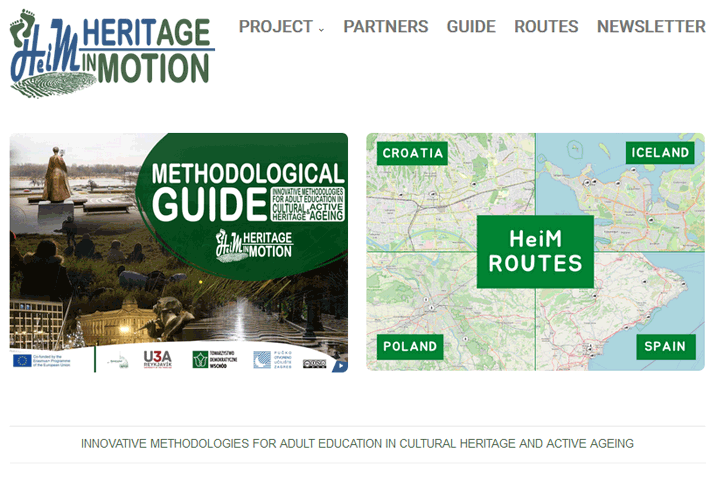
| Short descriptor of good practice |
| The Heritage in Motion project promotes knowledge of local and European heritage in order to foster its values among citizens, to recognize it as an essential resource for the development of European society and to contribute to its dissemination and conservation. The project also develops and implements innovative teaching methods that value the experience and skills of people over 50. The proposed action-research methodology offers this group the opportunity to continue lifelong learning in innovative environments and to be an active part of society, thus avoiding their exclusion and promoting inter-generational cohesion. |
| Type of setting where good practice is delivered |
| · The Permanent University of the University of Alicante · The Public Open University of Zagreb; · The U3A Reykjavik (NGO) · The Democratic Society East Foundation Knowledge of the English language – There are four partners participating in this project, therefore, they need English as the main language in order to communicate between them, which makes older adults to use the language that will help them with their linguistic skills. |
| Time Frame for delivery of good practice |
| Erasmus+ KA2 Strategic Partnerships for adult education The project lasted since 2018. until 2021., and was devided in three stages: ANALYSIS AND STUDY A mapping of the possible heritage resources for older adults. TRAINING PROGRAMME Innovative techniques for older adult training were implemented during this phase, encouraging trainers to use innovative tools; and training older adults with new skills. After the training, the students have acquired the necessary knowledge and skills to prepare active routes on heritage. RESEARCH ON ROUTES Each country prepared different heritage routes that are published on the project web page in order to facilitate accessibility to the research undertaken. |
| Type of learner the best practice is supporting |
| – Elders over 50 (20 per country) – Adult trainers (5 per country) – Experts – academics, scientists and professionals providing a broad overview of the heritage (at least 5 per country) |
| Resources used as part of good practice |
| www.heimheritage.eu |
| Aims and objectives of good practice |
| · To promote the cultural, cognitive, physical, and scientific development of the elderly. · To foster knowledge of heritage and the values of the European Year of Heritage. · To develop and implement innovative methods of teaching older people. · To promote among older people high quality activities and research of social relevance to minimize the impact of ageing and retirement. |
| Evidence as to why this was considered good practice |
| The participants in the project have designed 21 routes that highlight the heritage of their countries: https://www.heimheritage.eu/basic-page/routes Tourist boards and tourist offices, museums and town councils are using the routes created by the partners and find it interesting to use the methodology for the design of active heritage routes for older people. Methodological guide was created: https://www.heimheritage.eu/basic-page/methodological-guide Newsletter was published: https://www.heimheritage.eu/basic-page/newsletter |
| 3 Key learning Principles that were used in this good practice to support senior learners |
| 1. Participation 2. Experiential Learning 3. Readiness to learn |
| Any additional learning that we can take from this good practice example |
| / |
| Any Additional Information |
| / |
